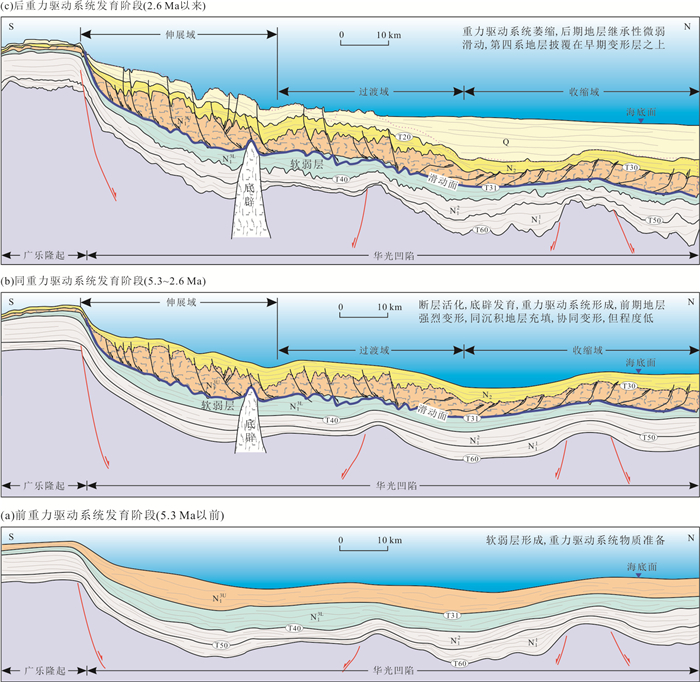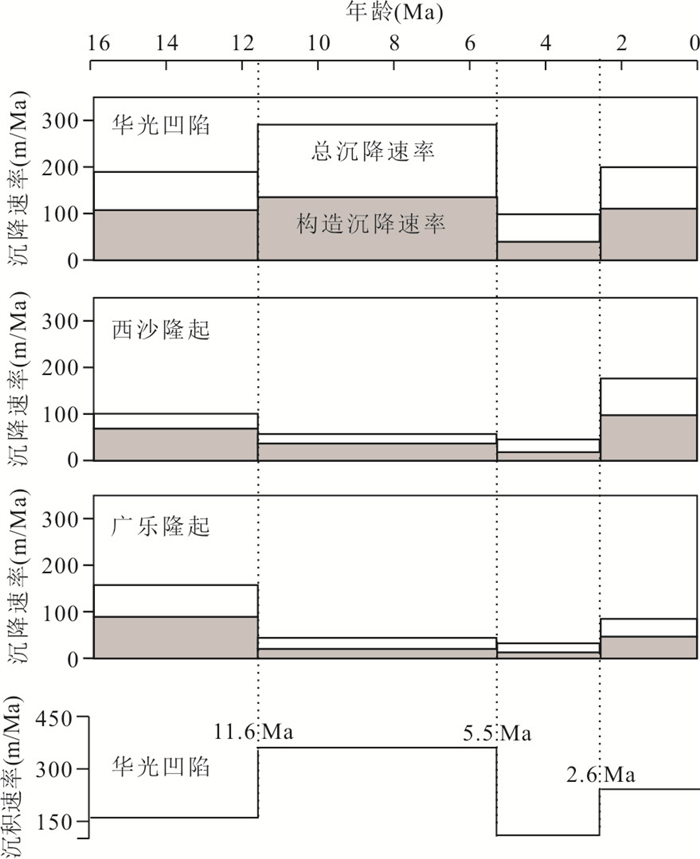Characteristics and Genetic Mechanism of a Large-Scale Submarine Gravity-Driven System in Huaguang Depression, Qiongdongnan Basin
-
摘要: 海底重力滑动系统研究对认识海底斜坡稳定性和深水沉积过程具有重要意义.南海北部琼东南盆地华光凹陷上中新统及其以上地层中发育一个大型的自南向北滑动的海底重力滑动系统.利用区域二维地震资料,查明了该大型海底重力滑动系统的地震相和发育特征,探讨了其可能的形成原因.该海底重力滑动系统由伸展域、过渡域、收缩域、滑动面和软弱层等5个要素构成;其发育演化可划分为晚中新世前重力滑动、上新世同重力滑动和第四纪后重力滑动等3个阶段:前重力滑动为物质准备阶段,水道复合体沉积于半深海泥质斜坡之上,为重力滑动提供物质基础;同重力滑动为重力滑动系统发育的主体阶段,沉积物披盖在强烈变形而产生的地形上,同时也发生一定程度的变形;后重力滑动为重力滑动系统萎缩阶段,沉积物逐渐将重力滑动产生的凸凹地形填平,并继续沉积.斜坡地形和高沉积物供给是海底重力滑动系统发育的基础;基底断层活化和底辟作用可能是触发其发育的动力源.Abstract: The study on submarine gravity-driven system (SGDS) is of great significance to understand the stability of submarine slope and the deep-water sedimentary processes. A large-scale SGDS sliding from south to north developed in the upper Miocene and above strata in the Huaguang depression of the Qiongdongnan basin, northern margin of the South China Sea. Based on regional 2D seismic data, in this paper it describes the characteristics of seismic facies and development of this large-scale SGDS and discusses its genetic mechanism. The development of the SGDS, composed of five elements including extensional domain, transitional domain, contractional domain, sliding surface and weak layer, could be divided into three stages as follows: the Late Miocene pre-gravity-sliding stage, the Pliocene syn-gravity-sliding stage, and the Quaternary post-gravity-sliding stage. During the fore-gravity-sliding stage, the channel complex was deposited on the bathyal argillaceous slope, and served on the material basis for gravity sliding. During the syn-gravity-sliding stage, which is the main stage of the SGDS development, the sediments were draped on the topography caused by intense deformation, and at the same time, there was also a certain degree of deformation. During the post-gravity-sliding stage, meaning the shrinking of the SGDS, the sediments gradually filled up the topography caused by gravity sliding and continued to deposit. It is indicated that the slope topography and high-speed sediment supply is the basis for the development of the SGDS, and the activation of basement faults and diapirism may be the trigger for its development.
-
图 2 海底重力滑动系统构成要素及其演化序列(剖面平行滑动方向,位置见图 1)
pre-GDL.前重力滑动层;syn-GDL.同重力滑动层;post-GDL.后重力滑动层
Fig. 2. Main elements and evolutionary sequence of the submarine gravity-driven system (SGDS)
图 3 海底重力滑动系统伸展域(BB’)和收缩域(CC’)地震反射特征
剖面垂直滑动方向,位置见图 1; pre-GDL.前重力滑动层;syn-GDL.同重力滑动层;post-GDL.后重力滑动层
Fig. 3. Characteristics of seismic facies in the extensional and contractional domains of the SGDS
图 4 海底重力滑动系统滑动面及其局域构造层地震反射特征
剖面垂直滑动方向,位置见图 1; pre-GDL.前重力滑动层;syn-GDL.同重力滑动层;post-GDL.后重力滑动层
Fig. 4. Characteristics of seismic reflection of the sliding surface and local tectonic layers of the SGDS
-
Alsop, G. I., Weinberger, R., Marco, S., et al., 2021. Detachment Fold Duplexes within Gravity-Driven Fold and Thrust Systems. Journal of Structural Geology, 142: 104207. https://doi.org/10.1016/j.jsg.2020.104207 Alves, T.M., 2015. Submarine Slide Blocks and Associated Soft-Sediment Deformation in Deep-Water Basins: A Review. Marine and Petroleum Geology, 67: 262-285. https://doi.org/10.1016/j.marpetgeo.2015.05.010 Bull, S., Cartwright, J., Huuse, M., 2009. A Review of Kinematic Indicators from Mass-Transport Complexes Using 3D Seismic Data. Marine and Petroleum Geology, 26(7): 1132-1151. https://doi.org/10.1016/j.marpetgeo.2008.09.011 Butler, R. W. H., Turner, J. P., 2010. Gravitational Collapse at Continental Margins: Products and Processes; An Introduction. Journal of the Geological Society, 167(3): 569-570. https://doi.org/10.1144/0016-76492010-003 Carter, A., Roques, D., Bristow, C.S., 2000. Denudation History of Onshore Central Vietnam: Constraints on the Cenozoic Evolution of the Western Margin of the South China Sea. Tectonophysics, 322(3-4): 265-277. https://doi.org/10.1016/S0040-1951(00)00091-3 Chen, H., Xie, X. N., Mao, K. N., et al., 2020. Depositional Characteristics and Formation Mechanisms of Deep-Water Canyon Systems along the Northern South China Sea Margin. Journal of Earth Science, 31(4): 808-819. https://doi.org/10.1007/s12583-020-1284-z Clift, P. D., Sun, Z., 2006. The Sedimentary and Tectonic Evolution of the Yinggehai-Song Hong Basin and the Southern Hainan Margin, South China Sea: Implications for Tibetan Uplift and Monsoon Intensification. Journal of Geophysical Research: Solid Earth, 111(B6): B06405B6. https://doi.org/10.1029/2005jb004048 de Vera, J., Granado, P., McClay, K., 2010. Structural Evolution of the Orange Basin Gravity-Driven System, Offshore Namibia. Marine and Petroleum Geology, 27(1): 223-237. doi: 10.1016/j.marpetgeo.2009.02.003 Fyhn, M.B.W., Boldreel, L.O., Nielsen, L.H., 2009. Geological Development of the Central and South Vietnamese Margin: Implications for the Establishment of the South China Sea, Indochinese Escape Tectonics and Cenozoic Volcanism. Tectonophysics, 478(3/4): 184-214. https://doi.org/10.1016/j.tecto.2009.08.002 Huhn, K., Arroyo, M., Cattaneo, A., et al., 2020. Modern Submarine Landslide Complexes: A Short Review. In: Ogata, K., Festa, A., Pini, G.A., eds., Submarine Landslides Subaqueous Mass Transport Deposits from Outcrops to Seismic Profiles. The American Geophysical Union and John Wiley and Sons, Inc., Washington, D.C., Hoboken, 183-200. Li, L. L., Shi, F. Y., Ma, G. F., et al., 2019. Tsunamigenic Potential of the Baiyun Slide Complex in the South China Sea. Journal of Geophysical Research: Solid Earth, 124(8): 7680-7698. https://doi.org/10.1029/2019jb018062 Li, X.X., Zhong, Z.H., Dong, W.L., et al., 2006. Paleogene Rift Structure and Its Dynamics of Qiongdongnan Basin. Petroleum Exploration and Development, 33(6): 713-721 (in Chinese with English abstract). http://www.researchgate.net/publication/283887282_Paleogene_rift_structure_and_its_dynamics_of_Qiongdongnan_Basin Liao, J., Gong, J.M., Chen, J.W., et al., 2020. New Discovery of Gravity Gliding Structure in the Offshore Indus Basin. Marine Geology Frontiers, 36(6): 76-79 (in Chinese with English abstract). Moscardelli, L., Wood, L., Mann, P., 2006. Mass-Transport Complexes and Associated Processes in the Offshore Area of Trinidad and Venezuela. AAPG Bulletin, 90(7): 1059-1088. doi: 10.1306/02210605052 Mosher, D.C., Moscardelli, L., Shipp, R.C., et al., 2010. Submarine Mass Movements and Their Consequences. 4th International Symposium. Springer, Netherlands, 1-8. https://doi.org/10.1007/978-90-481-3071-9_1 Ren, J.Y., Lei, C., 2011. Tectonic Stratigraphic Framework of Yinggehai-Qiongdongnan Basins and Its Implication for Tectonic Province Division in South China Sea. Chinese Journal of Geophysics, 54(12): 3303-3314 (in Chinese with English abstract). http://tga.cgu.org.tw/AbstractFinal/U6-P-27.pdf Ren, J.F., Sun, M., Han, B., 2020. A Giant Submarine Landslide and Its Triggering Mechanisms on the Nansha Trough Margin, South China Sea. Earth Science, https://kns.cnki.net/kcms/detail/42.1874.P.20200714.1059.008.html (in Chinese with English abstract). https://kns.cnki.net/kcms/detail/42.1874.P.20200714.1059.008.html Scarselli, N., McClay, K., Elders, C., 2016. Seismic Geomorphology of Cretaceous Megaslides Offshore Namibia (Orange Basin): Insights into Segmentation and Degradation of Gravity-Driven Linked Systems. Marine and Petroleum Geology, 75: 151-180. https://doi.org/10.1016/j.marpetgeo.2016.03.012 Shanmugam, G., Wang, Y., 2015. The Landslide Problem. Journal of Palaeogeography, 4(2): 109-166. https://doi.org/10.3724/SP.J.1261.2015.00071 Sun, Q.L., Xie, X.N., Wu, S.G., 2020. Submarine Landslides in the Northern South China Sea: Characteristics, Geohazard Evaluation and Perspective. Earth Sciences Frontiers, https://doi.org/10.13745/j.esf.sf.2020.9.3 (in Chinese with English abstract) Suo, S.T., 1983. On Gravitational Gliding Structures. Earth Science-Journal of Wuhan College of Geology, 22(3): 11-22 (in Chinese with English abstract) Terry, J. P., Winspear, N., Goff, J., et al., 2017. Past and Potential Tsunami Sources in the South China Sea: A Brief Synthesis. Earth-Science Reviews, 167: 47-61. https://doi.org/10.1016/j.earscirev.2017.02.007 Wang, D.W., Wu, S.G., Li, C.F., et al., 2016. Submarine Slide Evidence for Late Miocene Strike-Slip Reversal of the Red River Fault. Scientia Sinica (Terrae), 46(10): 1349-1357 (in Chinese with English abstract). Wang, D.W., Wu, S.G., Lü, F.L., et al., 2011. Mass Transport Deposits and Its Significance for Oil & Gas Exploration in Deep-Water Regions of South China Sea. Journal of China University of Petroleum (Edition of Natural Science), 35(5): 14-19 (in Chinese with English abstract). Wang, D.W., Wu, S.G., Qin, Z.L., et al., 2013. Seismic Characteristics of the Huaguang Mass Transport Deposits in the Qiongdongnan Basin, South China Sea: Implications for Regional Tectonic Activity. Marine Geology, 346: 165-182 doi: 10.1016/j.margeo.2013.09.003 Wang, H. R., 2007. Deep-Water Sedimentary Process-Response and Its Main Controlling Factors in the Northern Continental Margin of the South China Sea (Dissertation). China University of Petroleum, Beijing, 82-97 (in Chinese with English abstract). Wei, K.S., Cui, H.Y., Ye, S.F., et al., 2001. High-Precision Sequence Stratigraphy in Qiongdongnan Basin. Earth Science, 26(1): 59-66 (in Chinese with English abstract). http://en.cnki.com.cn/Article_en/CJFDTOTAL-DQKX200101011.htm Xie, X. N., Müller, R. D., Li, S. T., et al., 2006. Origin of Anomalous Subsidence along the Northern South China Sea Margin and Its Relationship to Dynamic Topography. Marine and Petroleum Geology, 23(7): 745-765. https://doi.org/10.1016/j.marpetgeo.2006.03.004 Xie, X. N., Müller, R. D., Ren, J. Y., et al., 2008. Stratigraphic Architecture and Evolution of the Continental Slope System in Offshore Hainan, Northern South China Sea. Marine Geology, 247(3/4): 129-144. Xie, X.N., Chen, Z.H., Sun, Z.P., et al., 2012. Depositional Architecture Characteristics of Deepwater Depositional Systems on the Continental Margins of Northwestern South China Sea. Earth Science, 37(4): 627-634 (in Chinese with English Abstract). http://en.cnki.com.cn/Article_en/CJFDTOTAL-DQKX201204003.htm Xie, X.N., Ren, J.Y., Wang, Z.F., et al., 2015. Difference of Tectonic Evolution of Continental Marginal Basins of South China Sea and Relationship with SCS Spreading. Earth Science Frontiers, 22(1): 77-87 (in Chinese with English abstract). http://en.cnki.com.cn/Article_en/CJFDTOTAL-DXQY201501009.htm Xu, J. J., Ren, J.Y., Luo, P., 2019. The Evolution of a Gravity-Driven System Accompanied by Diapirism under the Control of the Prograding West Luconia Deltas in the Kangxi Depression, Southern South China Sea. Marine Geophysical Research, 40(2): 199-221. https://doi.org/10.1007/s11001-019-09384-8 Yang, T.T., Wu, J.W., Wang, B., et al., 2012. Structural Pattern and Sediment Filling in Huaguang Sag of Southern Qiongdongnan Basin. Marine Geology & Quaternary Geology, 32(5): 13-18 (in Chinese with English abstract). http://en.cnki.com.cn/Article_en/CJFDTOTAL-HYDZ201205005.htm Yao, G.S., Yuan, S.Q., Ma, Y.B., et al., 2009. Deepwater Mass Transport Deposition System of Huaguang Depression, Qiongdongnan Basin and Its Significance for Hydrocarbon Exploration. Earth Science, 34(3): 471-476 (in Chinese with English abstract). http://d.wanfangdata.com.cn/periodical/dqkx200903011 Zhou, J., Yang, X.B., Yang, J.H., et al., 2019. Structure-Sedimentary Evolution and Gas Accumulation of Paleogene in Songnan Low Uplift of the Qiongdongnan Basin. Earth Science, 44(8): 2704-2716(in Chinese with English abstract). http://en.cnki.com.cn/Article_en/CJFDTotal-DQKX201908016.htm Zhu, M.Z., Graham, S., McHargue, T., 2009. The Red River Fault Zone in the Yinggehai Basin, South China Sea. Tectonophysics, 476(3/4): 397-417. https://doi.org/10.1016/j.tecto.2009.06.015 李绪宣, 钟志洪, 董伟良, 等, 2006. 琼东南盆地古近纪裂陷构造特征及其动力学机制. 石油勘探与开发, 33(6): 713-721. doi: 10.3321/j.issn:1000-0747.2006.06.014 廖晶, 龚建明, 陈建文, 等, 2020. 印度扇近海盆地重力滑动构造新发现. 海洋地质前沿, 36(6): 76-79. https://www.cnki.com.cn/Article/CJFDTOTAL-HYDT202006010.htm 任建业, 雷超, 2011. 莺歌海-琼东南盆地构造-地层格架及南海动力变形分区. 地球物理学报, 54(12): 3303-3314. doi: 10.3969/j.issn.0001-5733.2011.12.028 任金锋, 孙鸣, 韩冰, 2020. 南海南沙海槽大型海底滑坡的发育特征及成因机制. 地球科学. https://kns.cnki.net/kcms/detail/42.1874.P.20200714.1059.008.html doi: 10.3799/dqkx.2020.185 孙启良, 解习农, 吴时国, 2020. 南海北部海底滑坡的特征、灾害评估和研究展望. 地学前缘. https://doi.org/10.13745/j.esf.sf.2020.9.3 索书田, 1983. 重力滑动构造. 地球科学——武汉地质学院学报, 22(3): 11-22. https://www.cnki.com.cn/Article/CJFDTOTAL-MTXB201205023.htm 王大伟, 吴时国, 李春峰, 等, 2016. 晚中新世红河断裂走滑反转事件的海底滑坡证据. 中国科学(地球科学), 46(10): 1349-1357. https://www.cnki.com.cn/Article/CJFDTOTAL-JDXK201610006.htm 王大伟, 吴时国, 吕福亮, 等, 2011. 南海深水块体搬运沉积体系及其油气勘探意义. 中国石油大学学报(自然科学版), 35(5): 14-19. https://www.cnki.com.cn/Article/CJFDTOTAL-SYDX201105005.htm 王海荣, 2007. 南海北部大陆边缘深水沉积过程-响应及其主控因素(博士学位论文). 北京: 中国石油大学, 82-97. 魏魁生, 崔旱云, 叶淑芬, 等, 2001. 琼东南盆地高精度层序地层学研究. 地球科学, 26(1): 59-66. http://www.earth-science.net/article/id/810 解习农, 陈志宏, 孙志鹏, 等, 2012. 南海西北陆缘深水沉积体系内部构成特征. 地球科学, 37(4): 627-634. doi: 10.3799/dqkx.2012.072 解习农, 任建业, 王振峰, 等, 2015. 南海大陆边缘盆地构造演化差异性及其与南海扩张耦合关系. 地学前缘, 22(1): 77-87. https://www.cnki.com.cn/Article/CJFDTOTAL-DXQY201501009.htm 杨涛涛, 吴敬武, 王彬, 等, 2012. 琼东南盆地华光凹陷构造特征及沉积充填. 海洋地质与第四纪地质, 32(5): 13-18. https://www.cnki.com.cn/Article/CJFDTOTAL-HYDZ201205005.htm 姚根顺, 袁圣强, 马玉波, 等, 2009. 琼东南华光凹陷深水重力搬运沉积体系及其油气勘探. 地球科学, 34(3): 471-476. http://www.earth-science.net/article/id/1850 周杰, 杨希冰, 杨金海, 等, 2019. 琼东南盆地松南低凸起古近系构造-沉积演化特征与天然气成藏. 地球科学, 44(8): 2704-2716. doi: 10.3799/dqkx.2019.104 -










 下载:
下载:






